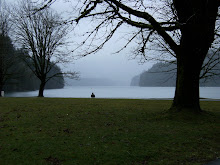...and me.
This will be (probably) the last of the MovNat AARs. Talking about training methodology.
I've written about Toby before. And here. And here. And teaching in general here. That's Toby Cowern of Tread Lightly Survival.
Wilderness survival, assault survival and movement have a lot in common. They are simultaneously complex and simple. Specifically the problems can be mind-bogglingly complex, but the solutions, in order to work, have to be simple. All three subjects are perfectly suited to the way people naturally think and move. All three subjects are almost in direct opposition to the way people are socially conditioned and taught to think and move. All three subjects wire to and work from the part of our brain that functions at primal levels with deep joy and deep pain. Almost all of civilization is specifically targeted to make these three subjects alien: We have grocery stores and central heating to avoid using wilderness survival skills; police and laws and eradicated predatory animals so we don't need assault survival and; cars and forklifts so we don't have to move and carry.
Just as there are principles in survival, and in movement, there are principles in teaching. My favorite teachers (and Vic moved onto the list) get that.
Good teaching is principles-based, and we've covered some of that in the last post.
A good teacher doesn't tell you what to think, but shows you how to think. Toby's "non-prescriptive" answers. Vic would ask the right questions, like "Where is the tension in your body? Is that helping or holding you back?" Or pointing out that if you want to move north, having your legs or feet moving west probably isn't helping.
It's about the student, not the instructor. The only reason I have any real assessment of Vic's physicality is because he attended a VioDy. At the MovNat seminar he demonstrated very little and his assistants demonstrated the minimum necessary to get you started, then the participants played. The ability of the instructor was irrelevant, the class was all about increasing the ability of the student.
At the instructor level, knowledge is insufficient. You need understanding. There was one technique in MovNat (part of the broad jump) that didn't jive with my previous training. When I asked why, the instructor (Stefano) was able to explain the reason behind the difference-- the environment in which my previous training was the right answer, why it would be right, when it would still be better than the MovNat way and the reason behind the MovNat difference. When instructors have just memorized technique, they don't have the tools to explain and are left with mere dogma. With understanding you can pass on the rules, and the exceptions, to the students.
Very little about right/wrong. Lots about better. Tied to the above point. I don't think I heard anyone being told they were doing anything wrong, but a lot of, "Try this, I think it will work better." There are lots of good teaching reasons to stay away from criticism.
And, tying into both of the last two points, there was no appeal to authority. It was all experiential. Never did Vic have to tell us something worked. When an instructor candidate pointed out a detail of your alignment or structure, there was an immediate, visible improvement. You only have to tell people something worked if it didn't actually work.
Vic was also cool with variation. I was one of the minority that had better balance with shoes on than off, and carrying a weight at chest level than at waist level. Extraordinary instructors are cool with not trying to force the statistical average onto the outliers.
Just as there is a natural movement for a human body, there is also a natural learning. Humans, like all animals, learn best through play. There's some stuff you have to talk about, and some stuff you want to play with in the gym, the studio or the lab. But playing, ideally in the real environment, is what locks in a skill. I led this post off with pointing out that some of the things closest to our evolutionary path are complex problems that require simple solutions. Play is the way we cut that Gordion knot.
Subscribe to:
Post Comments (Atom)



2 comments:
Set the what.. not the how...
It gets more challenging with those think it isn't working when it is... education and upbringing/conditioning that 'I'm not good at stuff' or that they were under pressure when they made the success.. and judge that adrenaline rush as a negative rather than being aware that they succeeded in the task
Post a Comment